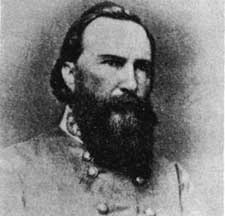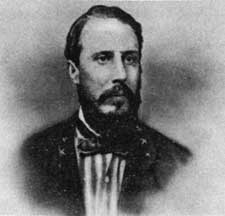|
GETTYSBURG National Military Park |
 |
 Lt. Gen. James Longstreet. Courtesy National Archives. |
 Col. Edward Porter Alexander. Courtesy National Archives. |
The Third Day
CANNONADE AT DAWN: CULP'S HILL AND SPANGLER'S SPRING. Night brought an end to the bloody combat at East Cemetery Hill, but this was not the time for rest. What would Meade do? Would the Union Army remain in its established position and hold its lines at all costs? At midnight Meade sought the advice of his Council of War in the east room of his headquarters. The corps commanders—Gibbon, Williams, Sykes, Newton, Howard, Hancock, Sedgwick, and Slocum—without exception advised holding the positions established. Meade, approving, turned to the officer whose division held the Union center, and said, "Gibbon, if Lee attacks me tomorrow it will be in your front."
Despite this prediction, Meade took no unusual measures next day to fortify the center of his line. In fact, by morning he seemed convinced that the Confederate attack would continue against his left. Thus the strong forces there, three corps, were left in place. Hancock's Second Corps, holding the center, did strengthen the stone wall running along its front. And General Hunt, Chief of Artillery, brought up reserve batteries to hold in readiness for replacement of front line guns.
Meanwhile, important movements were occurring elsewhere on the field. Ruger's division and Lockwood's brigade, which had been called from their lines on the south slope of Culp's Hill the previous evening to buttress the weakened Federal forces on Cemetery Ridge, had counter-marched, under cover of darkness, to reoccupy their ground. Geary, who had misunderstood orders and had marched down the Baltimore Pike, had also returned to his works, Ruger's men, upon reaching the Pike, learned from scouts that their entrenchments south of Culp's Hill and at Spangler's Spring had been occupied by the Confederates. Ruger, resolving upon an attack at daybreak, organized his forces along the Pike. Powerful artillery units under Muhlenberg were brought into place along the road; Rigby's Maryland battery was stationed on Power's Hill, a prominent knoll a half mile to the south; and another battery was emplaced on McAllister Hill.
As dawn broke on July 3, Union guns on the Baltimore Pike opened with a heavy cannonade on Johnson's Confederates at Spangler's Spring. The heavily wooded area about the Confederate lines prevented them from bringing guns into position to return the fire. Union skirmishers began streaming across the field toward the Confederate entrenchments. The full force of Ruger's and Geary's divisions was soon committed. Throughout the forenoon the opposing lines exchanged extremely heavy fire.
It was about 10 o'clock that Ruger, believing that a flank attack might break the resistance of Johnson's men, ordered Col. Silas Colgrove to strike the Confederate left flank near the spring. The troops of the 2d Massachusetts and the 27th Indiana regiments started across the swale from the cover of the woods on the little hill south of the spring. A withering fire slowed their pace, but they charged on, only to have their ranks decimated by the Confederates in strong positions back of a stone wall. Colonel Mudge, inspiring leader of the Massachusetts regiment, fell mortally wounded. Forced to fall back, the men soon learned their efforts had not been in vain. On Ruger's and Geary's front the Confederates were now giving way and soon had retired across Rock Creek, out of striking range. By 11 o'clock, the Union troops were again in possession of their earthworks; again they could quench their thirst in the cooling waters of the spring.

|

|
|
Last Modified: Mon, Sep 2 2002 10:00:00 pm PDT |


